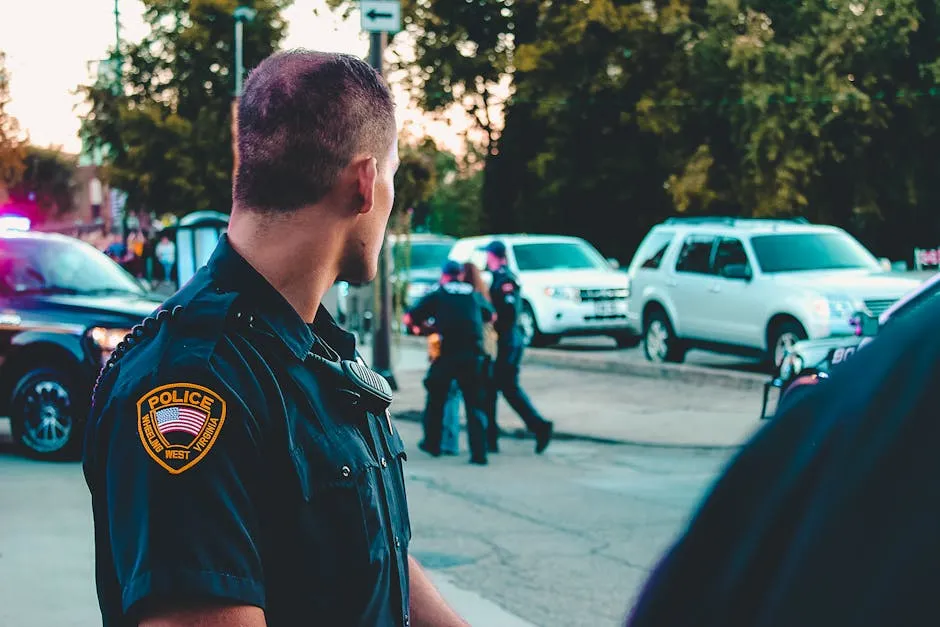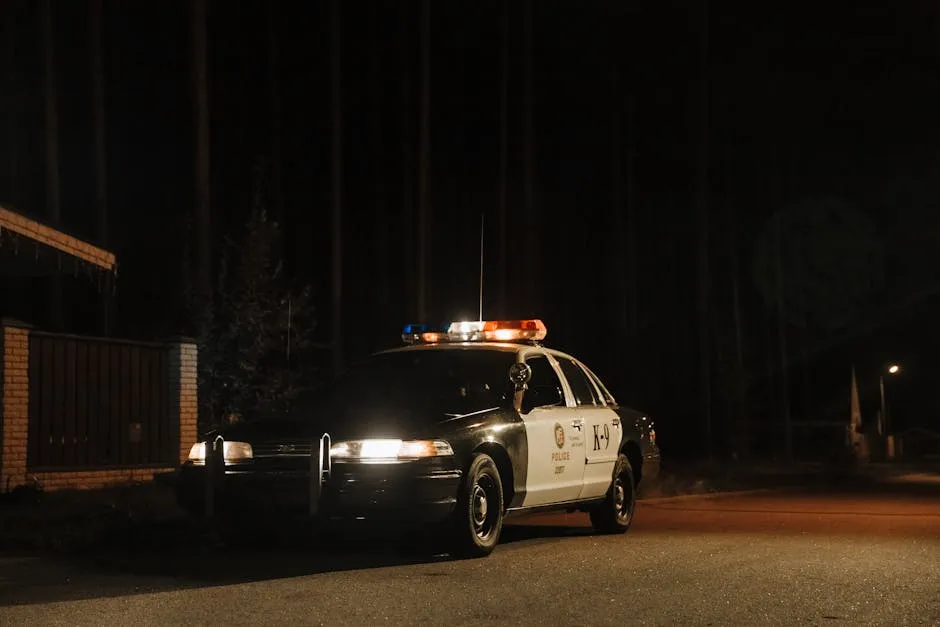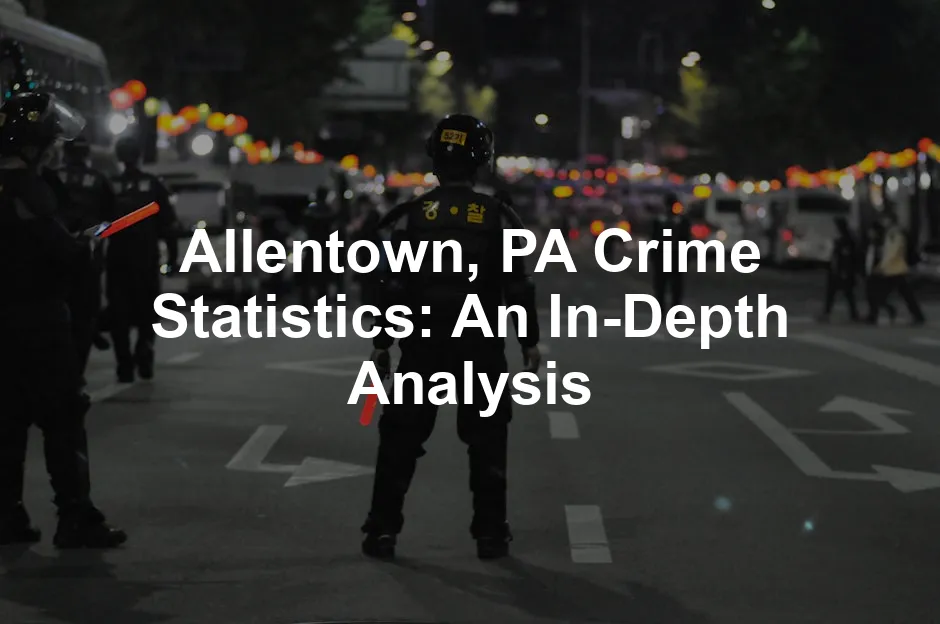Introduction
Allentown, Pennsylvania, isn’t just known for its vibrant festivals and delicious cheesesteaks. It’s also a city where understanding crime statistics becomes essential. Nestled in the Lehigh Valley, Allentown boasts a rich history and a diverse community. However, like many cities, it faces its share of safety concerns.
For residents, potential homebuyers, and curious visitors, knowing the crime landscape is crucial. After all, who wants to move to a neighborhood that feels more dangerous than a wild jungle? A glance at crime stats can help you gauge safety and make informed decisions.
Crime statistics don’t just paint a picture of safety; they can influence community perception and local policies. When crime rates are high, residents may call for more police presence or community programs. Conversely, lower crime rates can boost community pride and attract new residents. Speaking of community pride, what better way to spark a lively debate than with a good book? If you want a thought-provoking read, consider Crime and Punishment by Fyodor Dostoevsky. It’s a gripping tale that dives deep into moral dilemmas and societal issues, much like our exploration of crime in Allentown.
As we journey through the detailed analysis of Allentown’s crime statistics, we’ll uncover the realities behind the numbers. Buckle up; we’re about to take a ride through the twists and turns of crime data, community perception, and what it all means for Allentown!

Overview of Crime in Allentown, PA
Allentown, PA, has garnered a reputation for its higher-than-average crime rates. The numbers tell a story that’s hard to ignore. With a violent crime rate of 26.6 per 100,000 people, it exceeds the national average of 22.7. Property crime is even more pronounced, sitting at 43.6 compared to the national average of 35.4. Ouch!
What does this mean for residents? Well, it indicates a greater likelihood of encountering incidents such as robbery or assault. In a recent safety poll, opinions varied widely. About 41% of respondents felt “pretty safe,” while a concerning 22% reported feeling “not safe.” This spectrum of feelings reflects a community grappling with its safety image.
The city’s crime grade is a C minus. This rating raises eyebrows and sparks discussions about community safety initiatives. Residents might wonder, “What’s being done to improve our safety?” Understanding this crime grade can help in assessing the city’s local policies and community efforts. If you’re curious about how to enhance your home security, check out the Ring Indoor Cam. It’s a smart way to keep an eye on your home and feel a little safer.
Community perception also plays a significant role in shaping safety initiatives. Local leaders can use crime statistics to address residents’ concerns. This may lead to improved policing strategies or community programs aimed at prevention.
Statistics from Niche and AreaVibes reveal that Allentown’s crime rates are a hot topic. Whether for community gatherings or city council meetings, these numbers are more than mere figures. They are reflections of the community’s pulse. It’s essential to recognize how these statistics influence local policies and community engagement.
As we move forward, we’ll dive deeper into the specifics of Allentown’s crime statistics, painting a clearer picture of safety and security in this dynamic city. Let’s uncover the details that matter most to residents and visitors alike!

Crime Statistics Breakdown
Understanding crime statistics is crucial for Allentown residents. This section presents a comprehensive breakdown of both violent and property crime rates in the city, along with comparisons to national averages. Let’s jump into the numbers!
Violent Crime Statistics
Allentown has a violent crime rate of 26.6 incidents per 100,000 residents. This figure is notably higher than the national average of 22.7. But what exactly does this mean for the city? Let’s break down the specific types of violent crimes.
- Murder: Allentown records a murder rate of 5.7 per 100,000, which is slightly below the national average of 6.1.
- Rape: The city’s rate stands at 52.5, surpassing the national average of 40.7. This raises significant concerns about safety.
- Robbery: At 139.5 per 100,000, Allentown’s robbery rate is slightly above the national average of 135.5, indicating a potential trend in theft-focused offenses.
- Assault: With a rate of 188.7, assaults in Allentown are lower than the national average of 282.7, showing some positive news in this category.
In summary, while some violent crime metrics are concerning, particularly rape and robbery, others, like murder and assault, indicate a mixed bag for residents. Understanding the context of these crimes is essential, especially when looking at campus sexual assault statistics for broader implications.
Understanding violent crimes, including assault, is crucial for community awareness. Learn more about campus sexual assault statistics to gain insights into safety concerns.

Property Crime Statistics
When it comes to property crimes, Allentown sees a significant rate of 43.6 incidents per 100,000 residents. This is notably higher than the national average of 35.4. Let’s break this down further.
- Burglary: The burglary rate in Allentown is 427.6 per 100,000, compared to the national average of 500.1. This suggests a lower incidence of break-ins than seen nationwide.
- Theft: The theft rate is alarming at 1,656.1 per 100,000, considerably higher than the national average of 2,042.8. This highlights a persistent issue with non-violent property crime.
- Auto Theft: At 199.4, auto theft is notably lower than the national average of 284, indicating some degree of success in preventing vehicle-related crimes.
Overall, property crime remains a significant concern in Allentown, particularly when it comes to theft. Understanding these trends is crucial for community safety and awareness. If you want to keep your belongings safe, consider investing in a reliable AmazonBasics 8-Sheet Cross-Cut Paper and Credit Card Shredder. It’s a great way to protect your sensitive information!

Conclusion of Statistics
To sum it up, Allentown’s crime statistics reveal a city grappling with various safety challenges. While certain violent crimes are above national averages, others are holding steady or declining. Property crime presents a more significant challenge, especially regarding theft rates. The data emphasizes the importance of community initiatives and law enforcement efforts to address these issues effectively.

Crime Trends Over Time
Examining historical crime trends reveals the dynamics of safety in Allentown. Let’s look at how crime rates have evolved over the years and identify notable spikes or declines.
Historical Data Overview
The crime landscape in Allentown has experienced fluctuations over the years. For instance, in 2000, the violent crime rate was a staggering 670.8. This number has seen a decline over the years, with significant drops around 2015 and 2018. Notably, 2018 recorded a rate of 338.4, which was a dramatic decrease from previous years.
- Murder Rates: The murder rate peaked at 19.6 in 2005, but by 2022, it had fallen to just 4. This is a significant improvement and reflects effective law enforcement strategies.
- Rape and Assault: Rape rates have shown some upward trends in recent years, peaking at 54.2 in 2002, before fluctuating. Assaults, however, have decreased, with 2018 reporting just 138.8 per 100,000 residents.

Property Crime Trends
Property crime in Allentown has also shown varied trends. For example, burglary rates reached as high as 1,414 per 100,000 residents in 2009, but by 2022, they had significantly dropped to 129. The theft rate, however, remains a consistent problem, although it has seen minor fluctuations. If you want to learn more about how to tackle the issue of theft, consider reading The Gift of Fear: Survival Signals That Protect Us from Violence by Gavin de Becker. It’s a fascinating read that empowers you to trust your instincts.

Notable Events
Several events have influenced crime trends. Economic downturns often lead to spikes in property crime as individuals may resort to theft due to financial strain. On the flip side, community initiatives and increased police visibility have positively impacted crime rates over the years.
Conclusion of Trends
In summary, Allentown’s crime trends reveal a city that has made significant strides in reducing violent crime, particularly in murder rates. However, challenges remain, especially regarding property crimes. Understanding these trends helps residents and local leaders devise strategies for a safer community.

Comparative Analysis with Nearby Cities
When it comes to crime statistics, understanding how Allentown stacks up against neighboring cities is crucial. It’s like knowing the competition before signing up for a marathon—you want to see how you measure up, right? Let’s take a closer look at how Allentown’s crime rates compare to those of its nearby cities.
Crime Rates in Nearby Cities
Here’s a handy table that showcases the violent and property crime rates per 100,000 residents in Allentown and its neighboring areas:
| City | Violent Crime per 100k | Property Crime per 100k | Population | Year |
|---|---|---|---|---|
| Allentown, PA | 26.6 | 43.6 | 125,000 | 2022 |
| Salisbury Township, PA | 50.0 | 886.3 | 14,006 | 2019 |
| Catasauqua, PA | 211.5 | 1,782.7 | 6,562 | 2019 |
| South Whitehall, PA | 65.3 | 2,424.9 | 19,893 | 2018 |
| Fountain Hill, PA | 148.3 | 2,753.7 | 4,609 | 2018 |
| Whitehall Township, PA | 75.9 | 3,244.3 | 26,917 | 2018 |
Looking at the numbers, Allentown has a violent crime rate of 26.6 per 100,000 residents. While this number is higher than the national average of 22.7, it’s relatively low compared to Catasauqua, which boasts a staggering 211.5! Talk about raising the stakes.
On the property crime front, Allentown’s rate of 43.6 also surpasses the national average. However, it’s a mere fraction compared to Salisbury Township, which has a shocking property crime rate of 886.3. That’s more crimes than there are people in my last family reunion! If you’re looking for a way to enjoy your time outdoors without worrying about theft, consider getting a Coleman Portable Camping Quad Chair. Perfect for your next family outing!
In smaller municipalities like Fountain Hill and South Whitehall, the numbers are shockingly high in both categories. It seems Allentown may be the safer option for those looking to move nearby.

Comparing Allentown to Smaller Municipalities
When comparing Allentown to smaller municipalities, it’s important to note that population density and local economies often play significant roles in crime rates. Smaller towns can have sporadic spikes due to fewer overall incidents, while larger cities like Allentown can have a more consistent crime rate.
In essence, Allentown’s crime statistics present a mixed bag. While it’s not a crime-free utopia, it’s also not the wild west. Residents can take comfort knowing they’re in a city with crime rates that, while above average, are still lower than many nearby municipalities. And if you’re looking for a great read to unwind after a long day, The Alchemist by Paulo Coelho is a fantastic choice!

Conclusion
Allentown’s crime rates may not be perfect, but they do offer a clearer picture compared to many surrounding areas. It’s all about context, and understanding these statistics can help current and prospective residents make informed decisions. So, if you’re considering a move, it might be time to pack your bags—just keep an eye on the crime stats before you do!

Law Enforcement and Community Safety
Law enforcement plays an essential role in community safety. In Allentown, the effectiveness of police presence and community perceptions vary widely. Let’s dig into how residents feel about their safety and the law enforcement officers on the streets.
Overview of Police Presence
Allentown has a police force of approximately 232 full-time employees. This includes both sworn officers and civilian staff. When we break it down, that gives Allentown about 1.9 officers per 1,000 residents. Not too shabby, right?
Response times are another critical factor in assessing law enforcement effectiveness. While specific statistics can be elusive, many residents report that the police are generally responsive. In a recent poll, 44% of respondents felt that police visibility and responsiveness were commendable. That’s good news for residents looking for reassurance in their safety. If you want to maintain that sense of security at home, consider investing in a reliable FitBit Charge 5 Fitness and Health Tracker. It’s a great way to keep track of your health while staying active!

Community Relations and Poll Results
Public sentiment regarding safety in Allentown varies significantly. Based on a recent survey of residents:
- 41% feel pretty safe but acknowledge some concerns.
- 24% consider themselves somewhat safe but are aware of noticeable issues.
- 22% do not feel safe at all.
- 13% feel very safe, reporting no concerns.
These statistics reflect a community grappling with its safety image. While a majority express feeling secure, a significant portion remains apprehensive.

Law Enforcement Effectiveness
In terms of law enforcement effectiveness, the same poll indicated varying opinions:
- 44% of respondents praised police visibility and responsiveness.
- 18% felt that police were often absent when needed.
- 16% reported that while police were visible, their response times could improve.
These sentiments highlight a mixed relationship between the community and the police force. Residents crave a strong presence, and many believe it can be improved upon.

Conclusion
In summary, Allentown’s law enforcement and community safety perceptions reveal a city striving for improvement. While many residents appreciate the police presence, concerns linger. Building stronger community relations will be essential in enhancing overall safety. After all, a community that feels secure is a community that thrives!

FAQs
Is Allentown Safe for Families?
When pondering the big question of family safety in Allentown, it’s essential to look at more than just crime statistics. Families often seek a community where their kids can thrive and feel secure. So, how does Allentown measure up in this regard?
First, let’s talk about schools. Allentown is home to several public and private schools. The Allentown School District offers a range of educational options. Many parents appreciate the variety of programs available, from arts to sciences. However, it’s worth noting that school performance can vary. Parents often turn to GreatSchools.org for evaluations and reviews, helping them make informed decisions.
Community resources also play a vital role in family safety. The city offers parks, recreational programs, and community centers that serve as safe havens for kids. Programs like the Allentown Community Center provide engaging activities, after-school programs, and sports leagues. These resources not only keep kids busy but also foster a sense of belonging. When children feel connected, they’re less likely to wander into trouble.
It’s also essential to mention local initiatives aimed at improving safety. Neighborhood watch groups are becoming increasingly popular. These grassroots efforts encourage residents to look out for one another. Plus, they foster a sense of community spirit. If you have a watchful neighbor, it’s like having a built-in safety net!
In terms of crime perception, safety polls show that about 41% of residents feel “pretty safe.” However, a notable 22% of respondents express feeling “not safe.” This split highlights the need for continuous community engagement and safety initiatives.
While Allentown may have its challenges, it also boasts a welcoming environment for families. By staying informed and involved, parents can help shape a safer community for their children. And if you’re looking for a fun family activity, consider trying out the Ooni Karu 12 Multi-Fuel Pizza Oven. It’ll make pizza night a blast!

What Resources Are Available for Crime Victims in Allentown?
If you or someone you know has been a victim of crime in Allentown, fear not! The city offers various resources to support those affected. It’s crucial to know where to turn for help.
First on the list is the Allentown Police Department. They are not just there for law enforcement; they also provide victim assistance services. Their trained professionals can guide victims through the reporting process and help them access necessary resources.
In addition to the police, local nonprofits play a significant role. Organizations like the Crime Victims Council of the Lehigh Valley offer counseling, legal advocacy, and support groups. These services are designed to help victims heal and navigate the aftermath of their experiences.
The city also hosts hotlines for immediate assistance. The Pennsylvania Coalition Against Rape operates a hotline that victims can call for confidential support. Sometimes, just talking to someone who understands can make a world of difference.
Furthermore, local hospitals are equipped with resources for victims of violent crimes. They often have social workers on staff who can provide immediate support and connect victims with further assistance.
Lastly, community outreach programs aim to educate residents on safety measures and prevention. Events like safety workshops and self-defense classes empower individuals. They promote awareness about crime and how to protect oneself. If you’re interested in self-improvement, why not check out The 7 Habits of Highly Effective People by Stephen R. Covey? It’s a classic that can help you navigate life’s challenges.
Allentown may have its challenges, but it also has a robust support system in place for crime victims. By leveraging these resources, individuals can find the help they need to rebuild their lives and regain their sense of safety.
Please let us know what you think about our content by leaving a comment down below!
Thank you for reading till here 🙂
All images from Pexels




